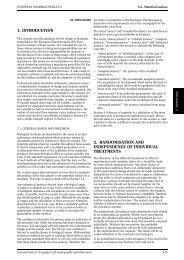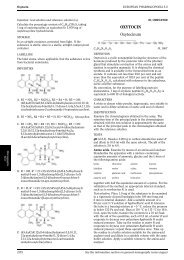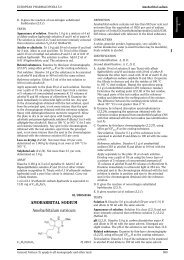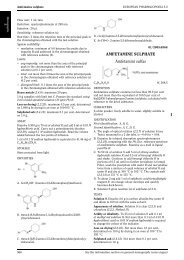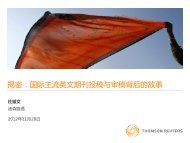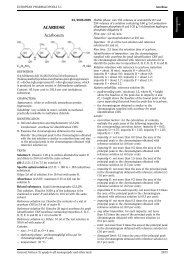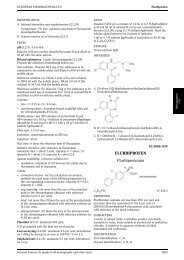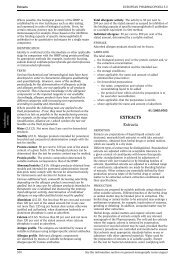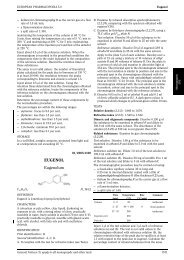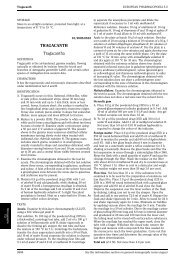FRAMYCETIN SULPHATE Framycetini sulfas
FRAMYCETIN SULPHATE Framycetini sulfas
FRAMYCETIN SULPHATE Framycetini sulfas
Create successful ePaper yourself
Turn your PDF publications into a flip-book with our unique Google optimized e-Paper software.
EUROPEAN PHARMACOPOEIA 5.0 Framycetin sulphate<br />
is not more intense that that in a standard prepared at the<br />
same time in the same manner, using 5 ml of phosphate<br />
standard solution (5 ppm PO4)R(500 ppm).<br />
Heavy metals (2.4.8). Dissolve 2.0 g in water R and dilute to<br />
20 ml with the same solvent. 12 ml of the solution complies<br />
with limit test A for heavy metals (10 ppm). Prepare the<br />
standard using lead standard solution (1 ppm Pb) R.<br />
Water (2.5.12). Not more than 0.5 per cent, determined on<br />
0.500 g by the semi-micro determination of water.<br />
A. 1,3-dihydroxy-2-(hydroxymethyl)propan-2-aminium<br />
(1,2-dihydroxypropyl)phosphonate,<br />
B. [2-[2-amino-3-hydroxy-2-(hydroxymethyl)propoxy]-1hydroxypropyl]phosphonic<br />
acid,<br />
ASSAY<br />
Examinethesubstancebyliquidchromatography(2.2.29).<br />
Prepare the solutions immediately before use.<br />
Test solution. Dissolve 0.60 g of the substance to be<br />
examined in the mobile phase and dilute to 5.0 ml with the<br />
mobile phase.<br />
Reference solution (a). Dissolve 0.60 g of fosfomycin<br />
trometamol CRS in the mobile phase and dilute to 5.0 ml<br />
with the mobile phase.<br />
Reference solution (b). Dissolve 8.7 mg of fosfomycin<br />
trometamol impurity A CRS (disodium salt) in the mobile<br />
C. 2-amino-3-hydroxy-2-(hydroxymethyl)propyl<br />
dihydrogenphosphate (trometamol phosphoric ester),<br />
phase and dilute to 20.0 ml with the mobile phase.<br />
Reference solution (c). Dissolve 5 mg of fosfomycin<br />
trometamol impurity A CRS (disodium salt) and 10 mg of<br />
fosfomycin trometamol CRS in the mobile phase and dilute<br />
to 5 ml with the mobile phase.<br />
Blank solution. A0.3g/lsolutionofanhydrous disodium<br />
D. [2-[[[2-[2-amino-3-hydroxy-2-(hydroxymethyl)propoxy]-<br />
1-hydroxypropyl]hydroxyphosphoryl]oxy]-1hydroxypropyl]phosphonic<br />
acid (trometamoyloxy<br />
fosfomycin dimer).<br />
hydrogen phosphate R in the mobile phase.<br />
The chromatographic procedure may be carried out using:<br />
— a stainless steel column 0.25 m long and 4.6 mm in<br />
01/2005:0180<br />
corrected<br />
internal diameter packed with aminopropylsilyl silica gel<br />
for chromatography R (5 µm),<br />
<strong>FRAMYCETIN</strong> <strong>SULPHATE</strong><br />
— as mobile phase at a flow rate of 1 ml/min a 10.89 g/l<br />
solution of potassium dihydrogen phosphate R,<br />
— as detector a differential refractometer maintaining the<br />
temperature at 35 °C.<br />
When the chromatograms are recorded in the prescribed<br />
conditions, the relative retention times (to fosfomycin) are<br />
about 0.3 for the two peaks corresponding to trometamol<br />
and 0.8 for impurity A.<br />
Inject 5 µl of reference solution (c). The test is not valid<br />
unless the resolution between the peaks corresponding to<br />
fosfomycin and impurity A is at least 1.5. Inject reference<br />
<strong>Framycetini</strong> <strong>sulfas</strong><br />
solution (a) six times. The test is not valid unless the relative<br />
standard deviation of the peak area for fosfomycin is at<br />
C23H46N6O13,xH2SO4 Mr 615 (base)<br />
most 1.0 per cent. Inject alternately the test solution and<br />
reference solution (a).<br />
Calculate the percentage content of fosfomycin trometamol.<br />
DEFINITION<br />
Sulphate of 2-deoxy-4-O-(2,6-diamino-2,6-dideoxy-α-Dglucopyranosyl)-5-O-[3-O-(2,6-diamino-2,6-dideoxy-β-Lidopyranosyl)-β-D-ribofuranosyl]-D-streptamine<br />
(neomycin B),<br />
STORAGE<br />
a substance produced by the growth of selected strains of<br />
Storeinanairtightcontainer.<br />
Streptomyces fradiae or Streptomyces decaris or obtained<br />
by any other means.<br />
IMPURITIES<br />
Content: minimum of 630 IU/mg (dried substance).<br />
CHARACTERS<br />
Appearance: white or yellowish-white powder, hygroscopic.<br />
Solubility: freely soluble in water, very slightly soluble in<br />
alcohol, practically insoluble in acetone.<br />
IDENTIFICATION<br />
A. Examine the chromatograms obtained in the test for<br />
related substances.<br />
GeneralNotices(1)applytoallmonographsandothertexts 1639
Framycetin sulphate EUROPEAN PHARMACOPOEIA 5.0<br />
Results:<br />
Relative retention with reference to neomycin B<br />
— the retention time of the principal peak in the<br />
chromatogram obtained with the test solution is<br />
approximately the same as that of the principal<br />
(retention time = about 10 min): impurity A = about 0.65;<br />
impurity C = about 0.9; impurity G = about 1.1.<br />
System suitability:<br />
peak in the chromatogram obtained with reference<br />
solution (a),<br />
— resolution: minimum 2.0 between the peaks due to<br />
impurity C and to neomycin B in the chromatogram<br />
— it complies with the limit given for impurity C.<br />
B. It gives reaction (a) of sulphates (2.3.1).<br />
obtained with reference solution (e); if necessary, adjust<br />
thevolumeofthecarbonate-freesodiumhydroxide<br />
solution in the mobile phase,<br />
TESTS<br />
— signal-to-noise ratio: minimum 10 for the principal peak<br />
in the chromatogram obtained with reference solution (c).<br />
pH (2.2.3): 6.0to7.0. Limits:<br />
Dissolve 0.1 g in carbon dioxide-free water R and dilute to<br />
10mlwiththesamesolvent.<br />
— impurity A: not more than the area of the principal<br />
peak in the chromatogram obtained with reference<br />
Specific optical rotation (2.2.7):+52.5to+55.5(dried<br />
substance).<br />
solution (d) and taking into account the declared content<br />
of neamine CRS (1.0 per cent),<br />
Dissolve 1.00 g in water R and dilute to 10.0 ml with the<br />
same solvent<br />
Related substances. Liquid chromatography (2.2.29).<br />
— impurity C: not more than the area of the principal peak<br />
in the chromatogram obtained with reference solution (b)<br />
(3.0 per cent),<br />
— total of other impurities: not more than the area of<br />
Test solution. Dissolve25.0mgofthesubstancetobetheprincipal<br />
peak in the chromatogram obtained with<br />
examined in the mobile phase and dilute to 50.0 ml with the reference solution (b) (3.0 per cent),<br />
mobile phase.<br />
— disregard limit: area of the principal peak in the<br />
Reference solution (a). Dissolve the contents of a vial of chromatogram obtained with reference solution (c)<br />
framycetin sulphate CRS in the mobile phase and dilute with (1.0 per cent).<br />
the mobile phase to obtain a solution containing 0.5 mg/ml. Sulphate: 27.0 per cent to 31.0 per cent (dried substance).<br />
Reference solution (b). Dilute 3.0 ml of reference solution (a)<br />
to 100.0 ml with the mobile phase.<br />
Dissolve 0.250 g in 100 ml of water R and adjust the solution<br />
to pH 11 using concentrated ammonia R. Add10.0ml<br />
Reference solution (c). Dilute 1.0 ml of reference solution (a)<br />
to 100.0 ml with the mobile phase.<br />
Reference solution (d). Dissolve the contents of a vial of<br />
neamine CRS (corresponding to 0.5 mg) in the mobile phase<br />
anddiluteto100.0mlwiththemobilephase.<br />
of 0.1 M barium chloride and about 0.5 mg of phthalein<br />
purple R. Titratewith0.1Msodium edetate adding 50 ml of<br />
alcohol R when the colour of the solution begins to change<br />
and continuing the titration until the violet-blue colour<br />
disappears.<br />
1mlof0.1 M barium chloride is equivalent to 9.606 mg of<br />
Reference solution (e). Dissolve 10 mg of neomycin<br />
sulphate CRS in the mobile phase and dilute to 100.0 ml<br />
with the mobile phase.<br />
SO4. Loss on drying (2.2.32): maximum 8.0 per cent, determined<br />
on 1.000 g by drying at 60 °C over diphosphorus<br />
Column:<br />
pentoxide R at a pressure not exceeding 0.7 kPa for 3 h.<br />
— size: l =0.25m,Ø=4.6mm,<br />
— stationary phase: base-deactivated octadecylsilyl silica<br />
gel for chromatography R (5 µm),<br />
— temperature: 25°C.<br />
Sulphated ash (2.4.14): maximum 1.0 per cent, determined<br />
on 1.0 g.<br />
Sterility (2.6.1). If intended for introduction into body<br />
cavities without a further appropriate sterilisation procedure,<br />
it complies with the test for sterility.<br />
Mobile phase: mix 20.0 ml of trifluoroacetic acid R, 6.0ml<br />
of carbonate-free sodium hydroxide solution R and 500 ml<br />
of water R, allow to equilibrate, dilute to 1000 ml with<br />
water R and degas.<br />
Bacterial endotoxins (2.6.14, Method D): lessthan 1.3 IU/mg if intended for introduction into body cavities<br />
without a further appropriate procedure for the removal of<br />
bacterial endotoxins.<br />
Flow rate: 0.7ml/min.<br />
Post-column solution: carbonate-free sodium hydroxide<br />
solution R diluted 1 in 25 previously degassed, which is<br />
added pulse-less to the column effluent using a 375 µl<br />
ASSAY<br />
Carry out the microbiological assay of antibiotics (2.7.2). Use<br />
framycetin sulphate CRS as the reference substance.<br />
polymeric mixing coil.<br />
STORAGE<br />
Flow rate: 0.5ml/min.<br />
In an airtight container, protected from light. If the<br />
Detection: pulsed amperometric detector with a gold substance is intended for introduction into body cavities,<br />
working electrode, a silver-silver chloride reference electrode store in a sterile, tamper-proof container.<br />
and a stainless steel auxiliary electrode which is the cell<br />
body, held at respectively 0.00 V detection, + 0.80 V oxidation LABELLING<br />
and −0.60 V reduction potentials, with pulse durations<br />
according to the instrument used.<br />
Injection: 10µl.<br />
The label states:<br />
— where applicable, that the substance is sterile,<br />
— where applicable, that the substance is free from bacterial<br />
Run time: 1.5 times the retention time of neomycin B. endotoxins.<br />
1640 See the information section on general monographs (cover pages)
EUROPEAN PHARMACOPOEIA 5.0 Frangula bark<br />
IMPURITIES<br />
A. R1=H,R2=NH2:2-deoxy-4-O-(2,6-diamino-2,6-dideoxy α-D-glucopyranosyl)-D-streptamine (neamine or neomycin<br />
A-LP),<br />
B.R1=CO-CH3,R2=NH2:3-N-acetyl-2-deoxy-4-O-(2,6 diamino-2,6-dideoxy-α-D-glucopyranosyl)-D-streptamine<br />
(3-acetylneamine),<br />
D.R1=H,R2=OH:4-O-(2-amino-2-deoxy-α-Dglucopyranosyl)-2-deoxy-D-streptamine<br />
(paromamine or<br />
neomycin D),<br />
C. R1 = CH2-NH2,R2=R3=H,R4=NH2: 2-deoxy-4-O-(2,6-diamino-2,6-dideoxy-α-D-glucopyranosyl)-<br />
5-O-[3-O-(2,6-diamino-2,6-dideoxy-α-D-glucopyranosyl)-β-Dribofuranosyl]-D-streptamine<br />
(neomycin C),<br />
E.R1=R3=H,R2=CH2-NH2,R4=OH: 4-O-(2-amino-2-deoxy-α-D-glucopyranosyl)-2-deoxy-<br />
5-O-[3-O-(2,6-diamino-2,6-dideoxy-β-L-idopyranosyl)-β-Dribofuranosyl]-D-streptamine<br />
(paromomycin I or neomycin<br />
E),<br />
F. R1=CH2-NH2,R2=R3=H,R4=OH: 4-O-(2-amino-2-deoxy-α-D-glucopyranosyl)-2-deoxy-<br />
5-O-[3-O-(2,6-diamino-2,6-dideoxy-α-D-glucopyranosyl)β-D-ribofuranosyl]-D-streptamine<br />
(paromomycin II or<br />
neomycin F),<br />
G.R1=H,R2=CH2-NH2,R3=CO-CH3,R4=NH2: 3-N-acetyl-2-deoxy-4-O-(2,6-diamino-2,6-dideoxy-α-Dglucopyranosyl)-5-O-[3-O-(2,6-diamino-2,6-dideoxy-β-Lidopyranosyl)-β-D-ribofuranosyl]-D-streptamine<br />
(neomycin<br />
B-LP).<br />
FRANGULA BARK<br />
Frangulae cortex<br />
01/2005:0025<br />
DEFINITION<br />
Frangula bark consists of the dried, whole or fragmented<br />
bark of the stems and branches of Rhamnus frangula L.<br />
(Frangula alnus Miller). It contains not less than 7.0 per cent<br />
of glucofrangulins, expressed as glucofrangulin A (C27H30O14; Mr 578.5) and calculated with reference to the dried drug.<br />
CHARACTERS<br />
It has the macroscopic and microscopic characters described<br />
under Identification tests A and B.<br />
IDENTIFICATION<br />
A. The bark occurs in curved, almost flat or rolled fragments<br />
or in single or double quilled pieces usually 0.5 mm<br />
to 2 mm thick and variable in length and width. The<br />
greyish-brown or dark brown outer surface is wrinkled<br />
longitudinally and covered with numerous greyish,<br />
transversely elongated lenticels; when the outer layers are<br />
removed, a dark red layer is exposed. The orange-brown<br />
to reddish-brown inner surface is smooth and bears fine<br />
longitudinal striations; it becomes red when treated with<br />
alkali. The fracture is short, fibrous in the inner part.<br />
B. Reduce to a powder (355). The powder is yellowish<br />
or reddish-brown. Examine under a microscope<br />
using chloral hydrate solution R. The powdered drug<br />
shows: numerous phloem fibres, partially lignified, in<br />
groups with crystal sheaths containing calcium oxalate<br />
prisms; reddish-brown fragments of cork; fragments of<br />
parenchyma containing calcium oxalate cluster crystals.<br />
Sclereids are absent.<br />
C. Examine the chromatogram obtained in the test for<br />
“Other species of Rhamnus; anthrones”indaylight.The<br />
chromatogram obtained with the test solution shows two<br />
orange brown zones (glucofrangulins) in the lower third<br />
and two to four red zones (frangulins, not always clearly<br />
separated, and above them frangula-emodin) in the upper<br />
third.<br />
D. To about 50 mg of the powdered drug (180) add 25 ml<br />
of dilute hydrochloric acid R and heat the mixture on a<br />
water-bath for 15 min. Allow to cool, shake with 20 ml of<br />
ether R and discard the aqueous layer. Shake the ether<br />
layer with 10 ml of dilute ammonia R1. Theaqueous<br />
layer becomes reddish-violet.<br />
TESTS<br />
Other species of Rhamnus; anthrones.Examineby<br />
thin-layer chromatography (2.2.27), using a suitable silica<br />
gel as the coating substance.<br />
Test solution. To 0.5 g of the powdered drug (180) add 5 ml<br />
of alcohol (70 per cent V/V) R and heat to boiling. Cool and<br />
centrifuge. Decant the supernatant solution immediately<br />
and use within 30 min.<br />
Reference solution. Dissolve 20 mg of barbaloin R in<br />
alcohol (70 per cent V/V) R and dilute to 10 ml with the<br />
same solvent.<br />
Apply separately to the plate, as bands, 10 µl of each solution.<br />
Develop over a path of 10 cm using a mixture of 13 volumes<br />
of water R, 17volumesofmethanol R and 100 volumes of<br />
ethyl acetate R. Allow the plate to dry for 5 min, spray with a<br />
50 g/l solution of potassium hydroxide R in alcohol (50 per<br />
cent V/V) R, and heat at 100-105 °C for 15 min. Examine<br />
in ultraviolet light at 365 nm. The chromatogram obtained<br />
with the reference solution shows a brownish-yellow<br />
zone corresponding to barbaloin in the central part. The<br />
chromatogram obtained with the test solution shows no<br />
zones of intense yellow fluorescence and no zone of orange<br />
to reddish fluorescence similar in position to the zone of<br />
barbaloin in the chromatogram obtained with the reference<br />
solution.<br />
Apply to another plate, as a band, 10 µl of the test solution<br />
and develop as described above. Allow the plate to dry for<br />
not longer than 5 min and spray immediately with a 5 g/l<br />
solution of nitrotetrazolium blue R in methanol R. Examine<br />
the chromatogram immediately. No violet or greyish-blue<br />
zones appear.<br />
Foreign matter (2.8.2). Not more than 1 per cent.<br />
GeneralNotices(1)applytoallmonographsandothertexts 1641



